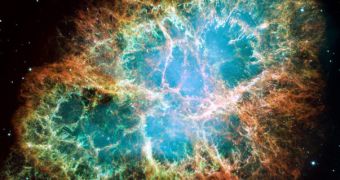The Crab Nebula has been a real puzzle for astronomers for the past century, since the measured age didn't correspond to historical accounts. Now, a team of scientists recalculated its explosion date and finally solved the longstanding riddle.
It is a supernova remnant in the constellation of Taurus, first observed in 1731 by John Bevis, containing a pulsar in its centre which rotates thirty times per second, emitting pulses of radiation, from gamma rays to radio waves. The nebula was the first astronomical object identified with a historical supernova explosion.
The team of researchers, led by Gwen Rudie, a senior physics major at Dartmouth and her adviser, Robert Fesen, along with Toru Yamada from Japan's Subaru Observatory in Hawaii, analyzed photos taken 17 years ago and compared them to the most recent ones, and were finally able to prove that its explosion was seen around the middle of the 11th century, from Earth.
"For the past 100 years astronomers have puzzled over the discrepancy between the measured age of the Crab Nebula versus the age suggested by numerous historical sightings around the ancient world," Rudie said. "This work verifies some long-standing assumptions about the nature of the Crab-with our result, science and history finally agree."
In 1054 A.D., Chinese, Japanese, Korean, and Arab astronomers reported seeing a new and unusual bright star in the skies, so brilliant that it was visible even during the day for nearly three weeks and only faded from view nearly two years later.
This new find clarifies the issue of the nebula's birth, which was highly controversial because of two factors. The first one is its location in the sky, which coincides with the reported position of this bright new star. But the second, a series of studies of the expanding cloud of stellar debris, seemed to indicate that it was expanding much too fast to be associated with a supernova explosion in 1054.
"Previous studies have focused on the main body of the Crab Nebula, which has been accelerated with time," Rudie explained. "We chose to look at the northern jet because it is father from the pulsar. That was the key to our new age determination."

 14 DAY TRIAL //
14 DAY TRIAL //